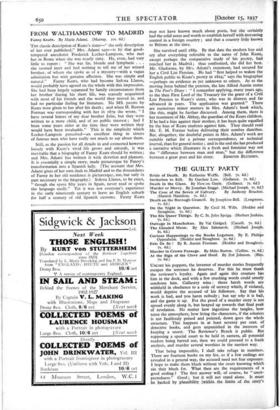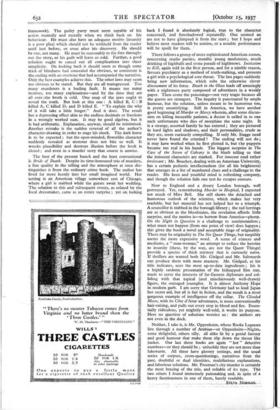THE GUILTY PARTY
The Case of the Seven of Calvary. By Anthony Boucher. (Hamish Hamilton. 7s. 6d.)
UNLIKE his puppets, the inventor of murder stories frequently escapes the sentence he deserves. For this he must thank the reviewer's loyalty. Again and again this creature has
him in the dock, and with a few crushing words could utterly condemn him. Gallantry wins : those harsh words are
withheld in obedience to a code of secrecy which, if violated, would deprive the accused of his followers. Say that his work is bad, and you harm nobody ; but say why it is bad,
and the game is up. For the proof of a murder story is not spread evenly along it, but heaped up towards that final peak of revelation. No matter how ingenious the tangles, how tense the atmosphere, how living the characters, if the solution is not faultlessly poised and pointed, down goes the whole structure. This happens in at least seventy per cent. of detective books, and goes unpunished in the interests of keeping a secret. The Reviewer's Bench is public. Bin supposing a special court to be held in camera, all potential readers being barred out, then we could proceed to a frank analysis, and murder several worthies in the nastiest way.
That being impossible, I shall take refuge in numbers. There are fourteen books on my list, so if a few endings are revealed in a general way, the accused need not fear exposure. I hope to make them blush without the court knowing which
sin they blush for. What then are the requirements of a good ending ? The first answer will, of course, be "unex- pectedness." Good ; but it will not stand alone. It must
be backed by plausibility (vyitlain the limits of the story's framework). The guilty party must seem capable of his action mentally and morally when we think back on his behaviour. He must also have an adequate motive (insanity is a poor plea) which should not be withheld from the reader until just before, or even after- his--diseovery. He should be one, not many He must be reasonably.to the fore through- out the story, or his guilt will leave us cold. Further, a good solution ought to cancel out all complications into sheer simplicity. On looking back- it should seem as though some trick of blindness had concealed the obvious, so consistent is the ending with an overtone that had accompanied the narrative. Only the best examples achieve this. The other laws may seem too obvious to be stated. But they are all transgressed. Too many murderers is a leading fault. It means too many motives, too many explanations—and by the time they are all over tthe broth is cold. One snap of the jaws ought to reveal the truth. But look at this one : A killed B, Cd-B killed A, C killed D, and D killed E. "To explain the why of it will take a little longer." And it does. The result has a depressing effect akin to the endless decimals or fractions In a wrongly worked sum. It may be good algebra, but it is bad arithmetic. Explanation, anyway, should be minimised. Another mistake is the sudden reversal of all the author's character-drawing in order to stage his shock. The dark horse is to be expected ; but the open-minded, flowerlike character suddenly revealed as monster does not bite so well. It wrecks plausibility and destroys illusion before the book is closed ; and even in a murder story that course is unwise.
The best of the present bunch and the least conventional is Bride of Death. Despite its time-honoured trio of murders, a fine quality in the telling and the atmosphere at once dis- tinguishes it from the ordinary crime book. The author has lived far more keenly into her small imagined world. Her setting is an American village somewhere east of Chicago, where a girl is stabbed while the guests await her wedding. The solution to this and subsequent events, as related by the local dressmaker, came as an entire surprise ; yet on looking
back I -found it absolutely logical, true to the character conCern-ed, and foreshadowed- repeaticilk. One- seethed an ass not to have glimpsed it from the start ; but I hope and believe most readers will be asinine, or a notable performance will be spoilt for them..'
There follows a group of more sophisticated American scenes, concerning studio parties, metallic young modernists, much drinking of highballs and some parade of highbrows. Invitation to Kill; again told in the first person, and for a nimble reason, favours psychiatry as a method of truth-stalking, and presents a girl with a psychological sore throat. The last pages suddenly bring new information, which robs the otherwise clever denouement of its force. Death in the Glass leads off amusingly with a nightmare party composed of advertisers in a weekly paper. Then come the poisonings—not very tragic because all the guests are strangers. The inquiry is punctuated by ample humour, but the solution, unless meant to be humorous too, is pretty unsatisfying. Still in America, we have another good beginning &Murder or Mercy wherein, after some discus- sion on killing incurable patients, it doctor is called in to one such unfortunate who dies of morphine the same night. It is a strange, assorted family he has entered ; they are pictured in hard lights and shadows, and their personalities, crude as they are, seem curiously compelling. If only Mr. Stagge need never have found the criminal ! The ending will not do ; it may have worked when he first plotted it, but the puppets became too real in his hands. The biggest surprise in The Case of the Seven of Calvary is the blurb telling us that the innocent characters are marked. For innocent read rather irrelevant ; Mr. Boucher, dealing with an American University, has a certain pedantic intellectualism (for all his brightness) that emerges in a list of numbered clues and a challenge to the reader. His keen and youthful mind is refreshing company, and though the solution fails one test he escapes censure.
Now to England and a dreary London borough, well portrayed. Yet, remembering Murder in Hospital, I expected too much of Miss Bell. She still shows the detached and humorous outlook of the scientist, which makes her very readable, but her material has not helped her to a triumph. A councillor is stabbed in the borough library ; the red herrings are as obvious as the bloodstains, the revelation affords little surprise, and the motive is—to borrow from America—phony. On the Night in Question is a challenge to sentimentalists ; what must not happen (from one point of view) does happen ; this gives the book a novel and acceptable tinge of originality. There may be originality in The Six Queer Things, but turgidity seems the more expressive word. A scene of seances and mediums, a "man-woman," an attempt to reduce the heroine to insanity (these, by the way, are not the Queer Things) provide a species of thick mystery that is curiously naive. If thrillers are wanted both Mr. Gielgud and Mr. Saltmarsh can produce them with more mastery. Mr. Gielgud, as his title indicates, uses the most up-to-date ingredients ; his is a highly sardonic presentation of the kidnapped film star, made to serve the interests Of far-Eastern' diplomats and col- liding with that topical (and _ mischievously well-drawn). figure, the outraged, journalist. It is almost Anthony Hope in modern garb. I alit sorry that Gen' na—nV hid to lend Japan her secret aid, but all is fair in fiction, and the result is a most gorgeous example of intelligence off the 'c011ar. The Cliiuded Moon, with its COte d'Azur adventures, is more conventionally hair-raising, and pulls out every stop in blood and fire. Essen- tially ridiculous, yet mightily well-told, it works its purpose. Here no question of solutions worries us : the authors are not even in the dock.
Neither, I take it, is Mr. Oppenheim, whose Rooke Legatees live through a number of Arabian—or Oppenheim—Nights, some delightful, others silly, all alike lit by a genial fantasy and good humour that make them slip down the throat like junket. Our last three books are again " hot " detective numbers—or they should be ; unluckily they are not ;more than lukewarm. All three have gloomy settings, and the usual series of corpses, cross-questionings, narratives from the past, doubtful or dual identities, multifarious explanations, and laborious solutions. Mr. Freeman's city Murder is certainly the most bracing of the trio, and reliable of its type. The two others I found immensely painstaking and, in spite of a heavy facetiousness in one of them, barely readable.























































 Previous page
Previous page